
There is something almost magical about hiking or spending time in the woods. The sounds of the birds and insects, the smell of the vegetation, it all just brings you back to a simpler time. Maybe, if you are lucky, you may even spot a mother deer with her fawn. Picking the ticks off when you get home, however, takes some of the magic away.
What are the differences between Deer ticks and regular ticks? A few differences between a deer tick and another common tick, the wood tick:
- A deer tick has a dark brown back while a wood tick has a more reddish back
- Unfed, a deer tick is usually about ⅛ inch long while a wood tick is about 3/16 inch
- Deer ticks carry Lyme Disease and Wood ticks carry Rocky Mountain Spotted Fever
Ticks, for their small size, can seem scarier than most horror movie monsters. This is due to the stories we have all heard regarding Lyme Disease.
From popular TV shows to medical horror stories, it is the rare person who has not at least heard of Lyme Disease. Which makes sense because it is scary. It is my goal to lessen these fears by imparting knowledge.
3 Differences Between Deer Ticks and Wood Ticks
A deer tick, also known as the Black-legged tick or Western black-legged tick, is called a deer tick due to its choice of mating spot and blood meal (the animal it prefers to eat from), although any species will do in a pinch.
Wood ticks, also known as the American dog tick, the brown dog tick or the Rocky Mountain wood tick, are called wood ticks because they are primarily found near the woods. Like the term “deer tick,” wood tick actually refers to a couple of species of ticks that prefer canines as their blood meal.
Size Differences Between A Deer Tick And A Wood Tick
When trying to identify a deer tick, it can be very difficult, especially when you consider how small they are. If you are bitten by a nymph, it may just be too small to properly identify. An adult, however, can be a little easier to identify.
The approximate size difference between the different stages are as follows:
- Larva – too small to see, about the size of a period.
- Nymph – not much bigger, they are about the size of a pinhead if not fed
- Adult – this varies between the two species. A deer tick is about ⅛ inch big and a wood tick is a little bigger at about 3/16 inch big.
Wood ticks are generally slightly larger. Females are about 5 mm long when they aren’t engorged. They grow to 15 mm long and 10 mm wide when engorged.
Color Differences Between Deer and Regular Ticks
One of the easiest ways to tell a deer tick from a wood tick is the color. When they are smaller, it can be more difficult to differentiate between the two, but as they grow, it is easier.
Deer ticks typically have a dark brown to blackish back, a brownish-grey abdomen (where it stores the blood), and black legs. Deer ticks do not typically have very distinctive markings on their backs.
Wood Ticks have a reddish-brown back and a lighter grey abdomen with legs that are a couple of shades lighter red. Adult wood ticks also have a distinctive lighter colored marking near its head.
The coloring of the lower back is the easiest way to tell the difference. The deer ticks lower back is red and a wood tick has a black lower back.
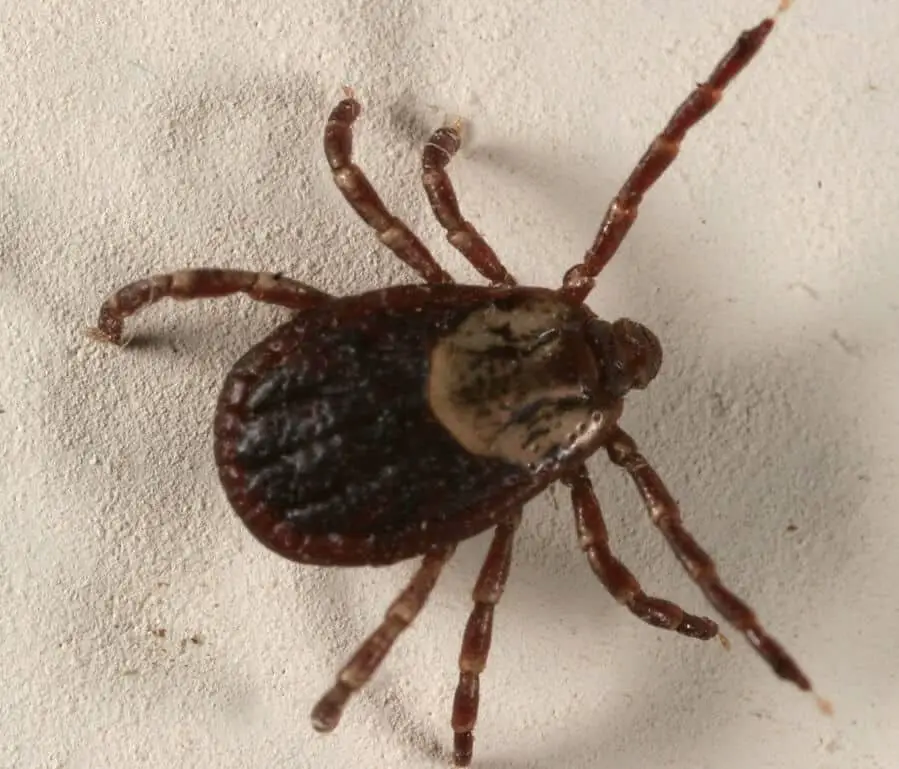
Illnesses of Deer and Wood Ticks
Each tick carries its own distinct illnesses as well. Knowing the difference which tick bit you can help a doctor determine which illness you may have been exposed to.
Deer Ticks – The black-legged tick and the western black-legged ticks are the only ticks that can carry the bacterium that causes Lyme Disease.
Wood Tick – There are actually three different varieties of ticks that can carry the same illness that a wood tick carries. The bacterium carried by the wood tick is a rickettsia, which causes Rocky Mountain Spotted Fever.
Considering that the symptoms of both illnesses are very similar, it can be hard to diagnose them without knowing what type of tick you were exposed to. Both illnesses, however, can be very dangerous if left untreated.
All About Deer Ticks
Ticks are one of a number of arachnids. Just as bugs such as spiders and scorpions are also arachnids, it simply means they are not insects.
In general, it means they are eight-legged, are wingless and do not have the same type of body segments as an insect. Though ticks are not spiders, they may seem to have a spider-like appearance.
Ticks are a type of external parasite which means that they attach themselves to the outside of their host. Most species of tick has a preferred host or host blood.
It is merely a chance that a human will get bitten by a tick since there aren’t any that prefer human blood over any other variety. We become victims of opportunity for these vicious vampires.
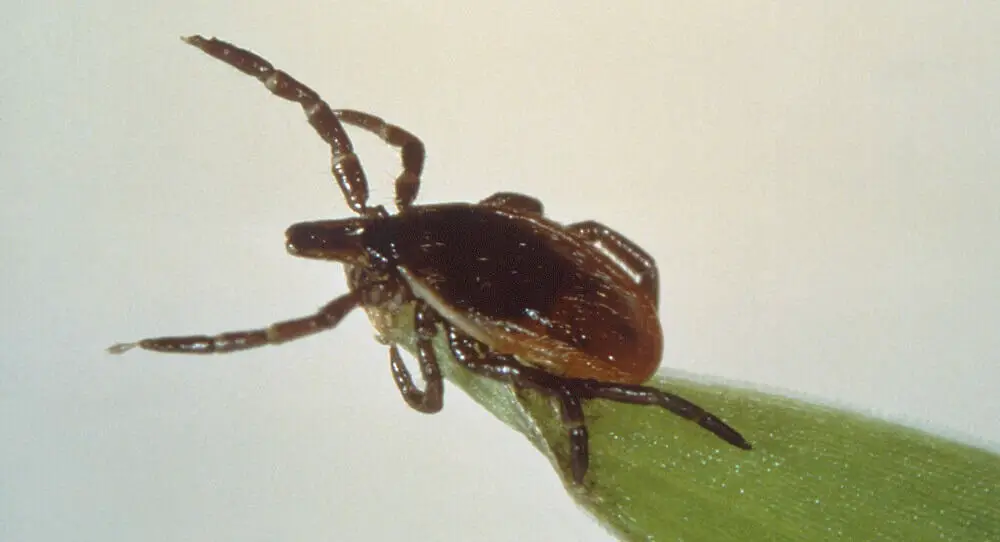
Deer Ticks and Their Characteristics
Deer ticks are the common name for black-legged ticks or western black-legged ticks. These are the only two species of ticks that transmit the bacteria responsible for Lyme Disease.
The name comes from their preferred blood host, the deer.
In the US, they prefer the White Tail Deer, but they are found on other species of deer, and they clearly do not restrict themselves to only deer.
Deer Tick Mating and Laying Eggs
The reason that black-legged ticks prefer deer is they use them to both mate on, and also to get that last blood meal before the females lay eggs.
The deer tick will feed only three times in its short life, and die shortly after laying her eggs. However, it can take her up to two weeks after breeding to fully lay all of her eggs before dying.
Feeding Habits Of Deer Ticks
When a deer tick feeds, it can be attached to the host for anywhere between three to five days drawing in blood. As it draws in blood, its abdomen will swell to many times its original size.
Starting out, a deer tick could be as small as a sesame seed or as large as a small eraser, depending on whether if it is a nymph or an adult. A fully grown adult, filled with blood, could be as large as a small grape or a large raisin.
Hard Shelled Ticks Vs. Soft Shelled Ticks
Some ticks have a hard shell, and some ticks have a softshell. Deer ticks are a type of hard shell tick as are the Lone Star Tick and the Brown American Dog Tick.
Soft-shelled ticks are seldom encountered by people. They usually come out at night to feed. They also prefer to feed on bats and birds. They are shaped and look a lot like a raisin.
Molting: Hardshell ticks will molt and grow three times, each time requiring a host and a blood meal. Softshell ticks, in comparison, require multiple meals since they will molt multiple times as nymphs.
Life Span: Hardshell ticks do not live as long as a soft-shelled tick. They live approximately 2 years and breed and lay eggs (about 3,000 of them) only once. Softshell ticks can live up to 10 years, have multiple smaller batches of eggs (around 300 or so at a time), and require more blood meals and more hosts.
Maturation: Due to their long lifetime, soft ticks also have a longer maturity rate. In the span of a hard shell ticks lifetime, a softshell tick won’t even be mature enough to breed yet.
What is Lyme Disease?
Lyme Disease is a very serious illness caused by a bacterium carried by a very small number of tick species. Lyme disease is an illness caused by four different bacteria.
The two bacteria that cause Lyme Disease and are found in the US and Canada are Borrelia burgdorferi and Borrelia mayonii. Borrelia afzelii and Borrelia garinii are found in Europe and Asia. Europe and Asia don’t have the deer tick, but they do have a sheep tick and a number of other species of ticks that are referred to as simply “tick.”
These bacteria can be carried by the black-legged tick or deer tick.
It is a bacterial infection that will not go away without treatment.
There are cases of patients who have been diagnosed with Lyme Disease a dozen years or so after the initial bite. This is why it is vital to see a doctor if you begin to feel ill within a month or so of getting a tick bite.
According to the CDC, 30,000 reports are made every year of Lyme Disease infection.
But, that number could be as high as 300,000. Some estimates are as high as 1.5 million cases a year in the US.
How Lyme Disease is Diagnosed and Treated
If Lyme Disease is suspected, then the first step is talking with a doctor. There are a couple of blood tests that he can order that will let him know if Lyme Disease is a possibility.
An EIA (Enzyme immunoassay) and IFA (Immunofluorescence assay) test will tell the doctor if you may have been exposed to the bacterium that causes Lyme Disease.
Depending on how long since the potential exposure, other tests may be ordered. Due to the extreme sensitivity of the EIA and IFA tests, they basically rule in or out the possibility of potential exposure, but they do not give a definitive diagnosis. The follow-up tests that are needed to confirm diagnosis do not pick up the antibodies right away after infection.
If it hasn’t been long since potential exposure to Lyme causing bacteria, your doctor will prescribe antibiotics to treat the infection.
Since Lyme Disease is caused by a type of bacteria, there are some antibiotics that are useful in treating it. With luck, several weeks of antibiotic treatment will make you feel good again.
If you are not feeling better by the end of your course of antibiotics, then you should return to the doctor in case it was a different bacterium that you were exposed to.
Keep in close contact with your prescribing physician is the best way to make sure you get the treatment that you need. Sometimes it may appear to be Lyme Disease when it is a different bacteria entirely.
If, however, it has been months or years since the bite, you may end up with longer-lasting effects from the Lyme Disease. This is why it is vital to go to the doctor as soon as possible after an infection is suspected. If that little bugger gets his teeth on you, if you feel symptoms, you need to see a doctor.
Even if you think you are being a hypochondriac, it is better to be safe than sorry and visit a doctor. The long-lasting effects of living with untreated Lyme Disease can have a huge impact on the quality of your health for the rest of your life.
The effects can be devastating and permanent, even if treated at a later time. Lyme Disease can damage the heart, affect the joints, and take a huge toll on your nervous system.
How to Prevent Tick Bites
It is important to be aware of ticks and take the appropriate measures to avoid tick bites. Be aware of whether the areas you live, visit, or travel through are areas with ticks.
Ticks can be found in most rural and scenic areas of the United States, Canada, Europe, and Asia. Other areas may have additional pockets of tick populations.
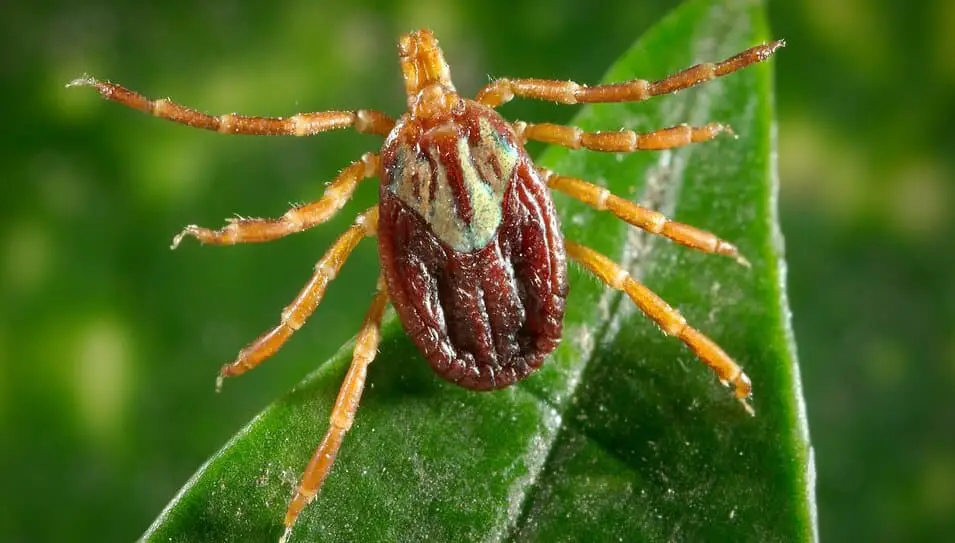
When enjoying time outdoors, take these steps to be tick-safe:
1. Reduce The Risk Of Ticks At Home
If you live in a rural area that has ticks, you can take steps to reduce the risk to yourself and your children. For a complete guide, check out How To Keep Ticks Out Of Your Yard, and Your Kids Safe (Pets Too).
The first summer after my family moved to the country, we found a tick on my youngest daughter. She had only been playing in the yard and garden. But we have never seen signs of ticks in our yard or wild field in the years since.
Why?
The year we moved into our house, it had been empty for several years. The yard was overgrown and there were high weeds everywhere. All those weeds are a great way to transport ticks. Plus, the animals were creeping in from the wild.
After we moved in, we kept the yard mowed, the weeds trimmed, and the wild things at bay. We repaired fences and traipsed all over our property.
Ticks travel on animals and keeping the weeds under control eliminated hiding places that animals liked to use. That meant no more ticks or at least a few enough that we haven’t run into them since.
- Trim bushes and trees
- Keep the yard mowed and in good shape
- Good fences help to keep our wild tick-carrying animals
- Employ predators of ticks
Did you know that chickens eat ticks? So do guinea fowl. If you are up for a little adventure, tasty eggs, and want to give your kids responsibility, then you can raise birds. Your birds will help to keep the tick population in your yard under control!.
2. Avoid High-Risk Areas When Hiking or Camping
Although ticks can likely be found all over the woods, sagebrush, and other wild areas, there are higher-risk areas than others.
Frequently used campgrounds and well-maintained trails are lower-risk areas. These places are usually maintained for comfort. Weeds and brushes are trimmed to make space for tents and campers.
But, less used trails or a hike through the brush is a higher risk area.
Once, my family was hiking in the midwest. Three of my family cut a trail where no one had gone before. All three found ticks on their clothing when they returned. No one else that stayed on existing trails found a tick.
Ticks mostly feed on animals. Animals tend to travel away from people. Ticks like to hitchhike from bushes. Trimmed and short bushes make it harder for them to hitchhike.
3. Cover Up When In High-Risk Areas
Wearing long pants and long-sleeved shirts can help to slow down any ticks that do hop on you. Make sure your pants are tucked into your socks and your shirt is tucked into your pants.
In the hiking scenario, no one in my family was bitten because they were well-protected. Eventually, the ticks would have found a way in, but heavy clothing tucked tightly kept them at bay until my family could check for ticks.
4. Check For Ticks Regularly
You need to check yourself, check anyone who was with you and any animals that were with you after you spend time outdoors.
Check as soon as you are in the house. Check every crack and crevice of your body. Ticks love dark, tight spaces.
This includes armpits, areas where your clothing is tight, such as waistbands, elastics around your socks, arms, or other areas. It includes the areas “down there.” Be thorough.
Don’t forget to check your children, or remind them to thoroughly check.
For your animals, make sure to check inside their ears, under the collar, etc.
The more often you check for ticks, the more likely you are to find them before they dig in deeply. At the very least, check for ticks at least daily.
If you are in a high-risk area, you can also check multiple times a day.
5. Remove All Ticks You Find.
Ticks can often take a little while to bite in and grab hold. Hopefully, you find the tick while it is still on your clothing or above your skin.
Removing a tick whose head is buried in your skin gets a little more complicated. We will cover what you should do in the next section.
Those that are already under your skin need to be removed carefully so as not to invite infection into the bite.
6. Protect Your Animals, And Yourself With Flea and Tick Treatment
Tick treatment is primarily used for dogs. It is important as dogs can track ticks into the home. One of the best is Revolution, which you can get from your vet in the United States.
How Ticks Travel and Find Victims
Ticks don’t fly or jump. When they are ready to molt as they grow, they just fall off their current victim.
Once on the ground they will molt (think of an adult crawling out of the used exoskeleton of a younger version) and begin looking for their next victim.
Often, they will crawl up a long blade of grass, or a bush, and just hang out until a victim walks past that they can grab onto. Whether this victim is human, canine or a deer, they really don’t care much. Blood is blood, and they are not really particular about where they get it.
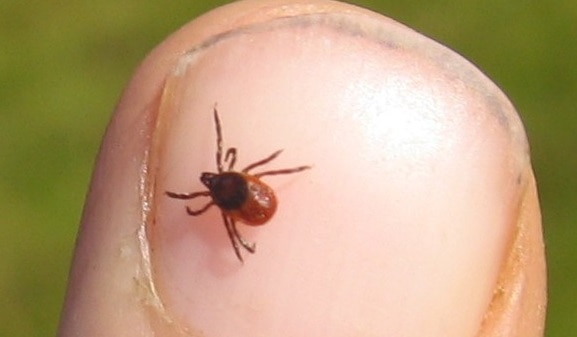
Once they are on a target, they will begin the potentially hours-long search to find the perfect spot.
Most ticks (at least hard ticks, like deer ticks) will feed anywhere for 3 to 5 days before getting full and dropping off. It is best to remove them as soon as they are found to minimize the risks of transmitted diseases.
Unlike bed bugs, ticks are not clean feeders. They mix the blood of previous hosts with the blood of the new host. That’s how the disease is spread.
Besides the risk of disease, it is just kind of gross. The entire time a tick is attached to you, it is basically spitting into your body. (Eww)
It is through their saliva that the different bacterium, including for Lyme Disease, is transmitted. Tick saliva is used as an anesthetic to prevent the host from noticing the parasite as it feeds.
This is also the reason why removed ticks should not be squeezed to be killed. If you want to ensure it’s death, just drop it into a capful of rubbing alcohol.
The alcohol will dry out the exterior of the body, basically leading to dehydration. Then take a picture of it and flush it.
What to Do if Bitten By a Tick
If you, a loved one or a pet (whether indoor or farm animal) is bitten by a tick, the first thing to do is to remove the tick and disinfect the area as quickly as possible.
Just because you were bitten does not guarantee you were infected with the bacterium that causes Lyme Disease. By removing the tick, it does reduce the risk of exposure, though not eliminating it.
Tick Removal
To remove a tick, you need to try to make sure that it is taken out in one piece. It may be gross and depending on your sensitivity, you may feel some pain or discomfort during the removal.
Anytime you have to remove a tick from a human, the date should be marked down, and a picture of the tick should be taken, just in case a doctor needs to identify it. I will go more into that later though.
If you have not yet been bitten but is just crawling on you, you can just pick it up and kill it. Ticks do not bite defensively, just be careful not to pinch or squeeze it.
If you have a cut, even a microscopic one, you could potentially be infected by the bacteria that it carries. While the risks are minimal, it is possible. Those risks increase if you are immunocompromised.
If you have already been bitten, then the game changes a bit. These tips also apply to remove ticks from your animals. There are actually a few methods that work, but none of the ones that work should include fire or petroleum jelly. Here is what I use to remove ticks:
- Clean the area with rubbing alcohol. This will minimize the risk of infection of outside bacteria.
- Using a pair of pointed tweezers, get as close to the head as possible. Special tick removal tweezers can be helpful but are not necessary.
- Grab onto the head of the tick securely, but don’t squeeze.
- Pull the tick straight back from the bite. If it is alive, you probably got it all.
- Put the tick in some rubbing alcohol or a secure container.
- Wash the area thoroughly with warm, soapy water.
- Take as clear of a picture of the tick as you can, in case you need to show a doctor in the future
I have also heard that fire can be used if the tick is very embedded. A little flame near the body will often, but not always, cause the tick to pull out of the skin. This method has some risk as you could also burn your skin while attempting it.
If the tick is embedded in quite a way, or if you can’t get it out without beheading it, you will need to seek medical attention to get it out.
A doctor or PA can cut an incision to get the tick out. Never leave a tick’s head in your skin as it will cause infection.
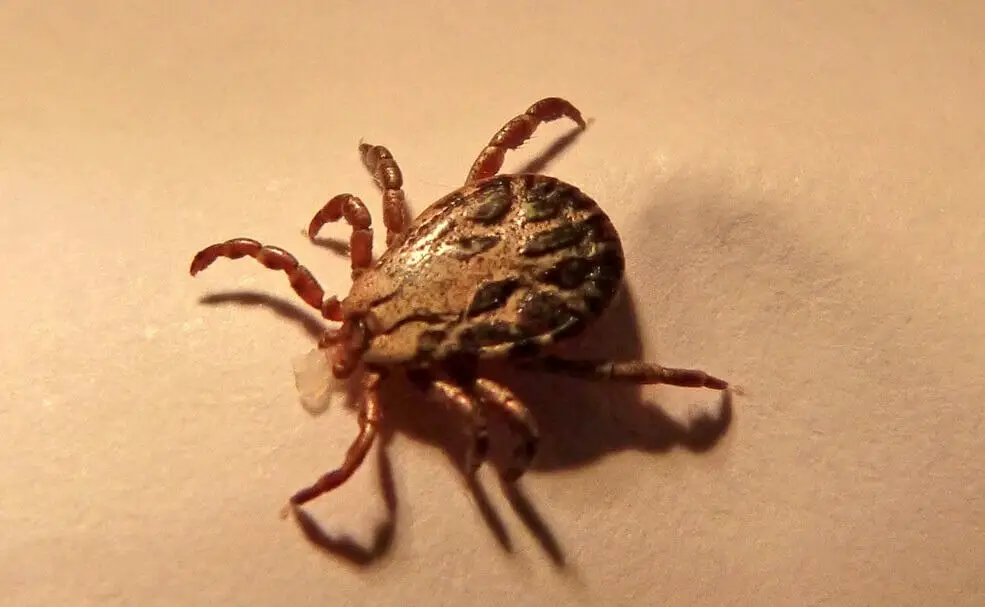
When to Seek Medical Attention
If you know you have been bitten by a tick and have been able to successfully remove it, you need to be aware of experiencing any of the following symptoms within a month of the bite. Should you experience any of the following flu-like symptoms, you should seek medical treatment immediately.
- Headache
- Nausea
- Muscle or joint aches
- Fever
- Chills
- Rash, especially a bullseye rash around the bite
If you do start to feel flu-ish, the moment the symptoms occur, you should set up an appointment with your Primary Care Physician to be looked at.
If you are lucky, it’s just the flu. It’s better to take a trip to the doctor to diagnose the flu than to risk not going and find out months or even years later that you have Lyme Disease.
While Lyme Disease is not the only disease you can get from ticks, it is potentially one of the most dangerous.
There are also things like Rocky Mountain Spotted Fever and Colorado Tick Fever among others that you could get. Ticks can be very dangerous to humans just because of the bacteria that they can carry. For this reason, just assuming you are fine is bad advice.
Did you know?
The long term risks of undiagnosed Lyme Disease can be both extensive and expensive.
Your heart could easily be damaged or weakened, which could cause a minor issue to put your life at risk. Of course there is also suffering with chronic pain.
Without the Lyme Disease diagnosis, you may be sentencing yourself to a very difficult time dealing with doctors that don’t believe your pain is as significant as it really is.
It is not uncommon for a chronic pain sufferer to find out, after years of trying to convince doctors how much they hurt, that they finally get a diagnosis of Lyme Disease.
Why Lyme Disease is Becoming So Common
If you have ever played with dominoes, you know that by setting them up just-so, you can push one down and the rest will follow.
Unfortunately, humans are the ones pushing that first domino, but it has been going on for generations. If you think of nature as the dominoes themselves, we are the kid pushing the first one over causing a cascading effect that is killing our world.
Lyme Disease is a perfect example of this.
Oak trees to seed, which we call acorns. Many animals survive by eating these acorns, including a tiny little rodent called the White Footed Mouse.
This mouse is the incubator of the bacteria that causes Lyme Disease.
Deer also eat the acorns.
As human habitation moves into the habitat of the natural predators of these mice, the White Footed Mouse population is exploding.
Without the previously high populations of birds of prey, like hawks and owls, hunting and limiting the number of these rodents, the population skyrockets. As their population explodes, so too does the number of ticks that are able to survive into adulthood.
As the larval forms of black-legged ticks feed on the blood of the mice, they get infected with the bacteria, but not affected by it.
They become what is called a vector, or an unaffected carrier of the bacteria. Ticks, as they grow into adulthood, infected with the bacterium, will bite deer, dogs, humans and other mammals, which result in the transmission of the bacterium.
This then results in more people getting sick or even dying from complications from Lyme Disease. While Lyme Disease itself will rarely actually kill someone, it can cause chronic lifelong issues that can aid in death.
Lyme Disease can weaken the heart, attack the nervous system, and cause issues and severe pain within the joints.
One thing we can do to help is to do our part to protect our local ecosystems. Animals like opossums are natural predators of ticks, and a single one can eat hundreds in a year. By protecting them, you can help to keep your home tick-free.
Conclusion
Ticks and the diseases they carry can be scary. Fortunately, you are now armed with the tools you need to identify them and to protect yourself and your family. It is possible to enjoy the outdoors without high anxiety or high risk.
Related Articles
You might also find these articles helpful.
How To Keep Ticks Out Of Your Yard, and Your Kids Safe (Pets Too).
Bed Bug Basics #1: Bed Bug Facts & Identification
21 Easy Ways To Keep Deer Away From Your Yard, Flowers, & Garden

